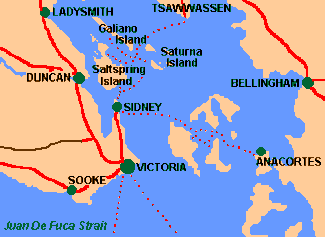
Bump the Bottom To Boat the Beauties
-by
D.C. Reid
A Trolling Tip for Sidney, BC

Twenty miles north of Victoria, the capital of British Columbia, Sidney boasts one of the few year-round chinook fisheries on the inside waters. What is the secret? - Sandlance and sand. Many local hotspots have sandy, eelgrass-covered bottoms. These attract needlefish in living carpets of tens of thousands of slim four inch fish. The abundance of feed in turn attracts successive waves of feeder chinook. Every week or two the size of the fish changes, indicating that new feeders have arrived.
The combination of bottom contour and available bait influences fishing tactics.
Chinook
are structure-related fish, meaning that they are found associated with underwater land features. In this case, in their pursuit of a meal, the chinook inhabit the layer of water nearest the bottom, keeping in touch with the needlefish that feed there.
Flattish, sand or mud-covered bottom prevails at most of the hotspots: Sidney Island and Spit; James Island and the Powder Wharf to the south end of the Island; and the red can buoy and mid-channel between James and the Sidney shores. A few of the hotspots, however, are rock bottomed and the fisher bottom bumps at his or her peril: Moresby Island and Fairfax Point; and, especially, Coal Island which is a drift fishers haven in the cutback, utilizing Buzz Bombs and Stingsildas at 20 - 60 feet.
For the uninitiated, bottom bumping is one of the more advanced trolling techniques. It requires a downrigger. Instead of mounting a release clip at the leadball end, the fisher mounts the clip ten feet up the downrigger line and then joins his fishing line at this point. This way the downrigger ball can be lowered right to the bottom, leaving the fishing line safely out of harms way some ten feet above snags and weed. Every time the downrigger handle jiggles, indicating that the downrigger ball is sliding across the bottom, the fisher reels in a bit of downrigger line. By keeping an eagle eye on the boat's depth sounder, the fisher can reel line in and out thus keeping his lure in the salmon zone.
Local guides swear by bottom bumping. Peter Payerl of Fun Fish Charters (Phone 1-250-652-7631) and Don McIvor of Affordable Fishing Charters (Phone 1-250-652-8436) say virtually all feeders in the area are taken in the bottom layer of water. In the Powder Wharf area, Peter says, "I fish at 90 to 100 feet following the contour line." Don agrees, "I fish the bottom 10 to 20 feet, trolling really slowly, following my charts." As for the lures employed in the Sidney waters, these imitate the small slender needlefish. Tiny strip, a slice taken from the side of a mature herring, matches with a green tiny-teaser head. Don fishes this 42" behind an Oki flasher. Peter, on the other hand, prefers to mount a flasher on the lead ball - a rather gutsy move in bottom bumping - and run his anchovy ten feet up without a flasher.
A few other lures a worth a try in this area. Remember though that, as with all saltwater locations, these are very specific and current information should be sought the day you go out. The longstanding hootchie for the area is the J79, a green with black combination, the stripe resembling the dark dorsal surface of the narrow needlefish. Other hootchies of mention include the mint tulip, army truck and J49. In plugs, the locals have definite preferences: numbers 500, 232, 191 and 158 in the Tomic line.
To add sport, Peter fishes exclusively with 20 pound test. "Sport is very important to me, and playing a fish without a flasher is far superior." Both expect good fishing this summer. Says Don, "Fishing has improved over the last three years and the fish are getting bigger." In his last trip he boated a 15, 18 and 21 pounder. The guides offer two final tips for the Sidney area. A slow troll is important, so every now and then take the boat out of gear. When the rod tip rises chinook will sometimes smack the lure that has stopped in front of their noses. Proper
electrical charge
will also induce more fish to bite the line. Both guides are firm believers in imparting electricity to the line in the range of .6 to .65 volts. If fish skitter around at the boat, lower this to .55 and they will come into the net more calmly, a big consideration in a
pink salmon
summer as these fish have very soft mouths.
This summer is indeed a lucky year. Peak
sockeye
runs may possibly top 20,000,000 fish. This combines with a hefty pink run of over 10,000,000 fish. You can expect to find both Don and Peter move over to the Pender Bluffs where both species hold on their final migratory approach to the Fraser River estuary. The Pender tip of the summer is fish the pink and sockeye a bit deeper here - 30 - 100 feet -, utilizing the pink plankton squirt and the Happy Hooker, a simple hook with pink flourescent tubing mounted on the shaft. Brand new flashy flashers are a must.
The
Sidney
area is easily reached by all modes of transportation. The Swartz Bay ferry terminal which receives vehicles from
Vancouver
is five miles away. The airport is across the highway. American vehicles may board in Anacortes, and boat cruisers can find quality sheltered moorage among the many marinas in the large harbour. Regardless of your method of getting to Sidney, remember that getting the beauties in the boat depends on bumping the bottom with bait.
More on fishing
Southern Vancouver Island
|




